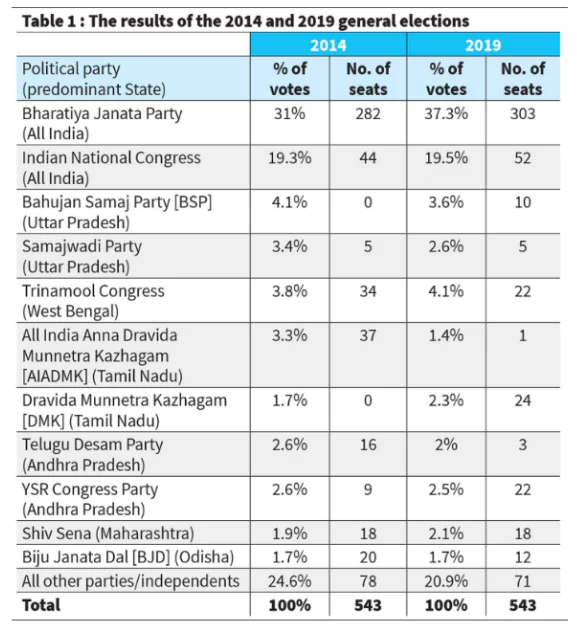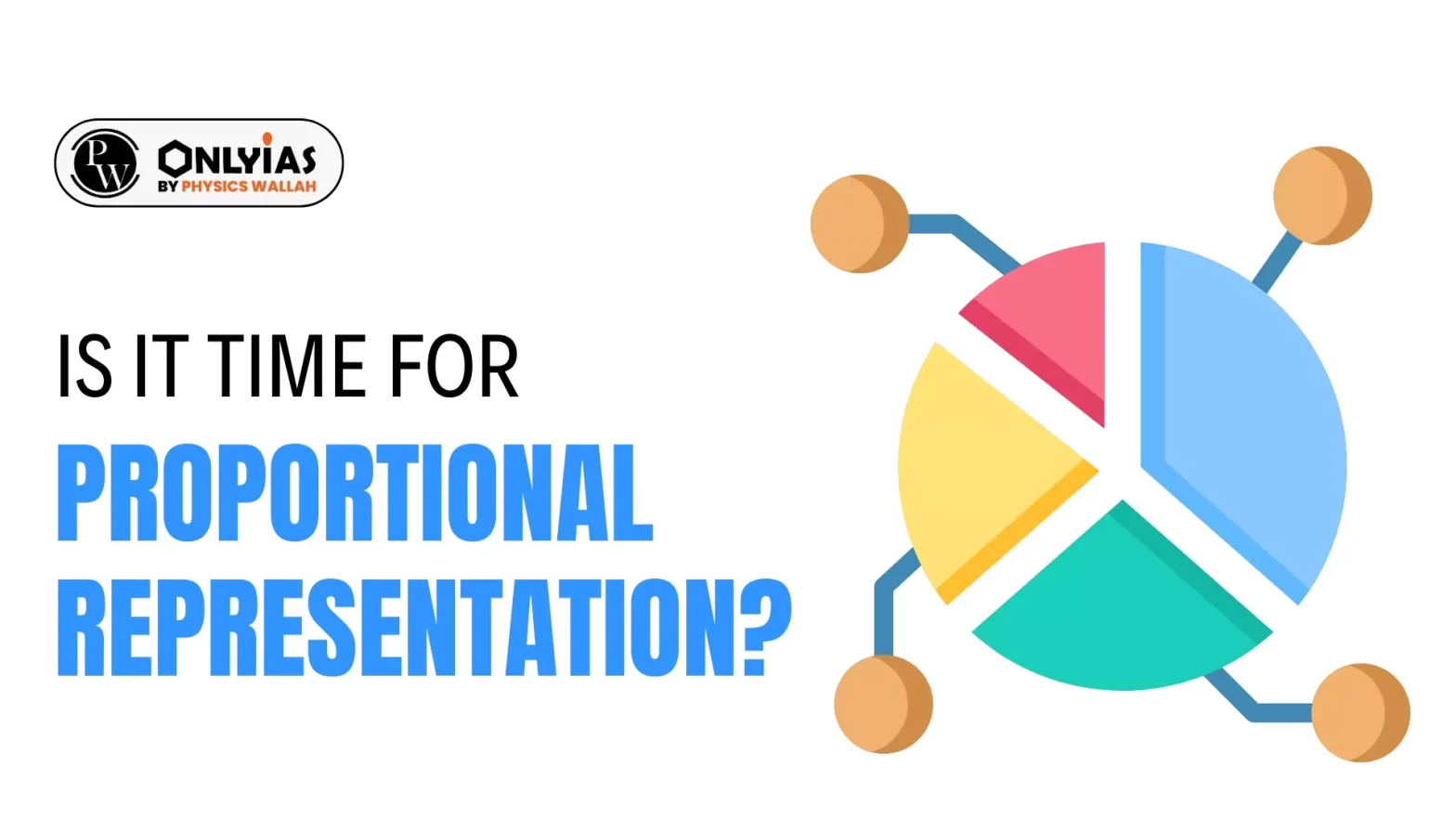The results of the Lok Sabha elections were declared recently. The ruling National Democratic Alliance (NDA) has won 293 seats with a 43.3% vote share while the Opposition bloc INDIA (including Trinamool Congress) has secured 234 seats with a 41.6% vote share. Other regional parties and independents polled around 15% but ended up with only 16 seats in total.
What is First Past The Post System?
We follow the First Past the Post System (FPTP) in our elections to the Lok Sabha and Legislative Assemblies. Under this system, the candidate who polls more than any other in a constituency is declared elected. This is the system that is followed for elections in democracies like the U.S., the U.K. and Canada.
Enroll now for UPSC Online Course
- The primary advantage of the first past the post system is that it is simple and the most feasible method in a large country like India.
- Secondly, FPTP provides greater stability to the executive in our parliamentary democracy because the ruling party/coalition can enjoy a majority in the Lok Sabha/Legislative assembly without obtaining majority of the votes (more than 50%) across constituencies.
- The issue with FPTP is that it may result in over or under representation of political parties when compared to their vote share. In the first three elections after independence, the Congress party won close to 75% of seats in the then Lok Sabha with a 45-47% vote share.
- Table 1, depicts a sample of this scenario after the general elections of 2014 and 2019.

What is Proportional Representation?
The Proportional Representation (PR) system ensures representation of all parties based on their vote share. The most commonly used PR system is the ‘party list PR’ where voters vote for the party (and not individual candidates) and then the parties get seats in proportion to their vote share.
- There is usually a minimum threshold of 3-5% vote share for a party to be eligible for a seat.
- India is a federal country and this principle if implemented should ideally be carried out at each State/Union Territory (UT) level.
- The scenario as it would have played out after the 2024 election results based on applying the PR system at each State/UT level is summarised in Table 2.

- Similarly, the NDA and the All India Anna Dravida Munnetra Kazhagam (classified in ‘Others’) would have had representation in Tamil Nadu where the INDIA bloc secured all 39 seats with a 47% vote share under the FPTP system.
- The main criticism against the PR system is that it could potentially result in instability as no party/coalition may obtain a majority to form the government in our parliamentary democracy.
- As can be seen, the PR system would have resulted in representation of parties according to their vote share.
- For example, in Gujarat, Madhya Pradesh and Chhattisgarh, totalling 66 seats, the NDA won 64 seats with a vote share of 62%, 60% and 53% respectively. Under the PR system, the INDIA bloc would have secured 23 seats in these States.
- The Biju Janata Dal (classified in ‘Others’) with a 42% vote share in Odisha would have secured nine seats as against no representation at present under the FPTP system.
- Further, it may result in the proliferation of political parties based on regional, caste, religious and linguistic considerations that may promote casteist or communal voting patterns.
- However, the second criticism is not well founded since the present FPTP system has also not inhibited the formation of parties based on caste or communal considerations.
- This issue can be addressed by specifying minimum threshold for votes polled in order to make a party eligible for seats in legislative houses.
- In order to maintain balance between stability and proportionate representation, the system of Mixed Member Proportional Representation (MMPR) can be considered.
- Under this system, there is one candidate who is elected through the FPTP system from each territorial constituency.
- There are also additional seats that are filled based on various parties’ percentage of votes.
Check Out UPSC NCERT Textbooks From PW Store
What are International Practices?
Presidential democracies like Brazil and Argentina have the party list PR system. So do parliamentary democracies like South Africa, the Netherlands, Belgium and Spain.
- In Germany, that follows the MMPR system, out of the 598 seats in the Bundestag (their equivalent of our Lok Sabha), 299 seats (50%) are filled from constituencies under the FPTP system. The voters also provide their preference for a party in the ballots.
- The balance 299 seats (50%) are filled by apportioning them amongst parties, that secure at least 5% votes, based on their percentage of votes.
- Similarly, in New Zealand, out of the total 120 seats in the House of Representatives, 72 seats (60%) are filled through the FPTP system from territorial constituencies.
- The balance 48 seats (40%) are allotted to various parties, that secure at least 5% votes, based on their vote share.
- This system is likely to provide the required stability in a parliamentary democracy like India while also ensuring representation for all parties based on their vote share.
What can be the Way Forward?
The law commission in its 170th report, ‘Reform of the electoral laws’ (1999), had recommended the introduction of the MMPR system on an experimental basis. It had suggested that 25% of seats may be filled through a PR system by increasing the strength of the Lok Sabha.
- While it had recommended to consider the entire nation as one unit for PR based on vote share, the appropriate approach would be to consider it at every State/UT level considering our federal polity.
- It is also pertinent to note that the delimitation exercise for increasing the number of seats is due based on the first Census to be conducted after 2026.
- The population explosion that happened in our country during the last five decades has been uneven among various regions.
- Determining the number of seats in Lok Sabha solely in proportion to population may go against the federal principles of our country and may lead to a feeling of disenchantment in the States that stand to lose through such representation.
Enroll now for UPSC Online Classes
Conclusion
India’s electoral system may benefit from exploring Mixed Member Proportional Representation to balance stability with fair representation, addressing current challenges and fostering inclusivity.
![]() 11 Jun 2024
11 Jun 2024




